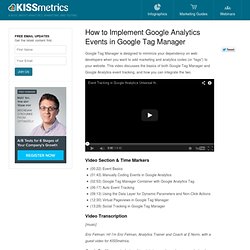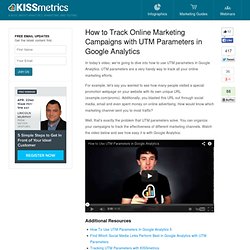

Apps Status Dashboard. <div id="aad-nojs">Please enable javascript to see the table containing service performance information.

</div> Apps <div id='aad-nojs'>Please enable JavaScript to see the table containing service performance information. </div> Apps Status Dashboard This page offers performance information for Google Apps services. Check back here any time to view the current status of the services listed below. Products covered by Google Apps Service Level Agreement and Technical Support Service Guidelines: Products not covered by Google Apps Service Level Agreement: RSS Feed All times are shown in your local timezone unless otherwise noted.
No Issues Service disruption Service outage Google Home - Privacy - About Google - Support. How to Implement Google Analytics Events in Google Tag Manager. Google Tag Manager is designed to minimize your dependency on web developers when you want to add marketing and analytics codes (or “tags”) to your website.

This video discusses the basics of both Google Tag Manager and Google Analytics event tracking, and how you can integrate the two. Eric Fetman: Hi! I’m Eric Fetman, Analytics Trainer and Coach at E Norm, with a guest video for KISSmetrics. Google Tag Manager is designed to minimize our dependency on web developers for adding marketing and analytics code to our websites. This tutorial video is going to focus specifically on implementing Google Analytics Events in Google Tag Manager since this can be a little tricky the first time around. Let’s start off with some event basics. We’ve navigated to another page, the page has loaded, the page has changed, and data has been sent back to the Google Analytics servers.
What types of user actions don’t generate trackable page views? Let’s look at the mail to link as an example. [music] Hacking AdWords: Winning at AdWords the Weird Way. As search marketers, we spend a lot of time analyzing crazy SEO algorithms (hello, Panda and Penguin) and constantly trying to reverse-engineer ranking factors in an attempt to increase our organic rankings.

Yet when it comes to paid search, there's not nearly as much research, despite the fact that PPC, like SEO, is largely driven by an algorithm (Quality Score) which determines ad position, cost per click and many other factors. By understanding how Quality Score works, AdWords can be cracked. In my article today, I'll quantify the impact of Quality Score on your cost per click and cost per conversion.
What Is a Good CTR on Google AdWords? A very popular question, but unfortunately there is no such thing as a 'good CTR'.

Since CTR depends on many different factors and variables, it's just like asking 'what's a good income' (without knowing your field of work), 'what's a good speed to drive' (without knowing the local driving rules), and 'what's a good meal to order off the menu' (without knowing your tastes, preferences, budget, and lifestyle). So if anyone ever asks you to specify what constitutes a good CTR, here are 11 points to consider: 1. How long-tail is the keyword – longer tailed keywords generally have greater opportunity for tailored ads and generally receive a higher CTR. 2. 3. 4. 5. 6. 7. 8. 9. 10. 11. PPC marketing is rarely just about CTR. CTR is therefore generally most useful when comparing like for like, for example determining which ad message styles have the best CTR, or determining whether the CTR of a keyword has changed compared to the previous month. How to Track Online Marketing Campaigns with UTM Parameters in Google Analytics.
In today’s video, we’re going to dive into how to use UTM parameters in Google Analytics.

UTM parameters are a very handy way to track all your online marketing efforts. For example, let’s say you wanted to see how many people visited a special promotion webpage on your website with its own unique URL (example.com/promo). Additionally, you blasted this URL out through social media, email and even spent money on online advertising. How would know which marketing channel sent you to most traffic? Well, that’s exactly the problem that UTM parameters solve. Bryan: Hi, I’m Bryan with KISSmetrics, and I’m here to help you get the most out of your Google Analytics account. Imagine this, you spend months making this killer product, you’ve thrown up a landing page to it, and now you’re going to send out several tweets to drive traffic to your landing page. Now you want to step back and see which tweet drove the most traffic.
Today, I’m going to teach you about UTM Parameters. [music]